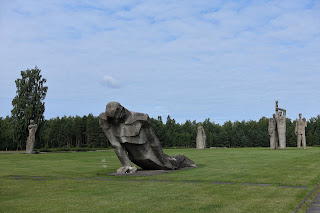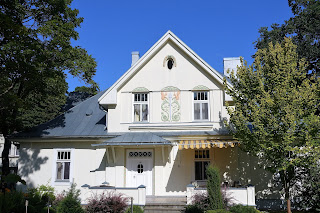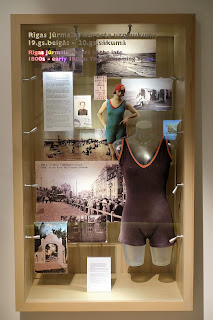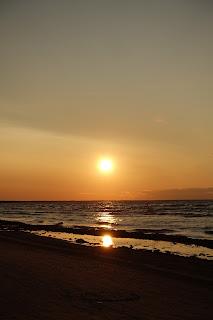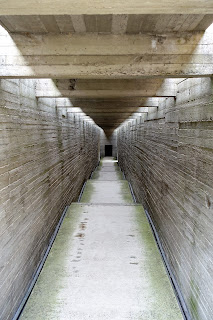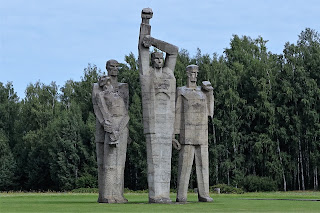Salaspils Concentration Camp Memorial
With the girls back only the weekend before from having spent most of the summer in Taiwan, and with my daughter starting school at the end of this month (old enough for middle school already?!), I took Friday and Monday off from work so that the family could squeeze in one last weekend at the seaside before the Lithuanian autumn and winter seasons set in. Our destination was the Baltic version of the French Riviera, the seaside resort/spa Jūrmala, a 32-kilometer-long strip of land comprising 14 townships located only 20 kilometers from the Latvian capital Riga. While the temperatures weren't warm enough to go for a dip in the chilly waters of the Baltic Sea, the weather was pleasant enough for strolling along the beach. It was a very relaxing weekend, the perfect way to end summer before school starts up again and work resumes. If you don't mind a Nazi concentration camp as a coda to the long weekend, however.
Before setting off on Friday afternoon for the four-hour drive from Vilnius to Jūrmala, we stopped to have lunch at the Open Kitchen, on the edge of Užupis. Here, food trucks and stalls from local restaurants set up every Friday during the summer. Shu-E and I dined on Vietnamese pho and spring rolls, while Amber enjoyed kebabs wrapped to resemble burritos:
Suitably fortified, it was an easy if somewhat monotonous drive north into Latvia, enlivened only briefly when our GPS directed us off the main highway and onto some dirt and semi-paved roads, presumably as a shortcut. We arrived in Jūrmala shortly before six, checked into the Alba Hotel (our daughter had her own adjoining room) and then went out for dinner at Della Mamma:
The first thing we did after breakfast on Saturday morning was head down to the beach, just a short walk from the hotel. Though it had rained late on Friday night, and continued to do so into the early morning hours, it was sunny and clear when we got up, and would remain that way for the rest of the day:
Other than its beaches, Jūrmala is known for its art nouveau wooden houses. A great place to check out some of them is along Jūras iela. Many serve as summer cottages for the monied class, but a surprising number are also abandoned or boarded up, while yet others are newer structures designed to mesh harmoniously with their older neighbors:
If you're not there for the beaches or the spas, there isn't a lot to do in Jūrmala except to stroll around at a leisurely pace. My daughter checks out a turtle sculpture; behind her is the Baltic Beach Spa, the largest such facility in the Baltic region:
The temperature on Saturday peaked at around 21° Celsius. Some people (like myself) were walking around in T-shirts and shorts, while others were bundled up in jackets and scarves. A few hardy souls waded into the somewhat cool waters of the Baltic Sea:
The main tourist drag is the pedestrian-only Jomas iela, where Amber and Shu-E made friends with one of the local felines:
While my wife relaxed on a park bench, my daughter and I went to visit the Art Rezidence 'Inner Light' gallery, run by a Russian artist out of his home just off of Jomas iela:
The artist produces glow-in-the-dark paintings using a secret recipe for fluorescence. The portraits morph as the lights dim while trippy New Age music plays in the background:
Amber loved it, and got a special kick (pun intended) from the way her shoes glowed in the UV light:
With mum still preferring to chillax on her bench, my daughter and I next visited the Jūrmala City Museum. The permanent exhibit explains the region's history as the most popular resort town in the former Soviet Union. Even today, Jūrmala still attracts large numbers of Belarusian and Russian visitors:
Amber adds her touch to the works of art displayed upstairs:
A special exhibit on the ground floor provides insights into Jūrmala's past as host to numerous Young Pioneers:
On the way back to our car, a procession of vintage vehicles from both the Eastern and Western blocs passed by us, going in the opposite direction:
We returned to Della Mamma for dinner for the second consecutive night. The girls frequently remarked at how I resemble the caricature for my friend Steve's English cram school 補習班 in Taichung 台中 more than he does, and lamented that I didn't have a blue baseball cap to make the image complete:
After dinner, the three of us headed down to the beach to watch the sun set over the Baltic Sea. Later, after Amber had gone to bed, Shu-E and I returned to the water's edge to gaze up in wonder at the starry sky overhead:
On Sunday morning we drove over to Lielupe, located between Jūrmala and Riga, to visit the Jūrmala Open-Air Museum, which preserves several 19th-century Latvian fishers' houses as well as a collection of various nautical equipment:
Amber and I then took a walk through the woods to the seaside while Shu-E (you guessed it) rested in the car:
We returned to Jomas iela to have lunch at Sue's Asia restaurant, for a break from the usual Baltic fare:
For the rest of the day, my daughter and I returned to Lielupe to enjoy the water slides and wave pools at the Līvu Akvaparks water park. My wife relaxed back at the hotel, claiming an aversion to water akin to that of a house cat or the Wicked Witch of the West:
After frollicking at the water park for several hours, Amber and I made one final visit to Jomas iela for dinner on Sunday evening. The food at the outdoor restaurant we chose was mediocre, but the post-dinner stroll along the street was enjoyable, helped immeasurably by Latvian chocolate ice cream:
All in all, it had been an enjoyable, relaxing weekend, as we left Jūrmala on Monday morning. Before heading back to Vilnius, however, I decided to make a stop at a more sobering location, the Salaspils Concentration Camp Memorial, between Latgale and Riga. Run by the Nazis from October 1941 to October 1944, Salaspils wasn't a death camp, but conditions for the inmates housed in its 39 barracks (most Latvian leftists and Soviet POW's) were harsh, with many not surviving the experience. As you approach the memorial, the first thing you see is a huge concrete bunker with the inscription "Behind this gate the earth groans":
A six-meter-long block of polished stone lies outside the bunker, inside which ticks a metronome, sounding eerily like a human heartbeat:
There were two things about the concentration camp memorial that I took issue with. The first was its description as "a remembrance place of fascist victims", an exercise in semantics by the Soviets who created the memorial in 1967. A more accurate description would be of "totalitarian victims", but that would also include those who died at Stalin's hands. The second issue was the gigantic stone figures, examples of Soviet gigantism, whose grotesque appearances detract from what should be a poignant, thought-provoking experience for the visitor:
In contrast, the simple children's camp memorial packed a far more powerful emotional punch:
And so another summer is winding down. My wife and daughter are back "home", bringing a sense of normalcy with them. My daughter will start the sixth grade this week, no longer the little girl I used to carry in my arms or push around in her stroller - she's almost as tall as her mother, in fact. This fall I'll learn where my next assignment will take us. One friend of mine has already decided to leave the Foreign Service, while there are times when I wonder if life would be easier if I just went back to teaching English in Taiwan. So far, however, the pluses are outweighing the minuses. Only time will tell...
What is this Lithuanian wooden figure grinning about?
